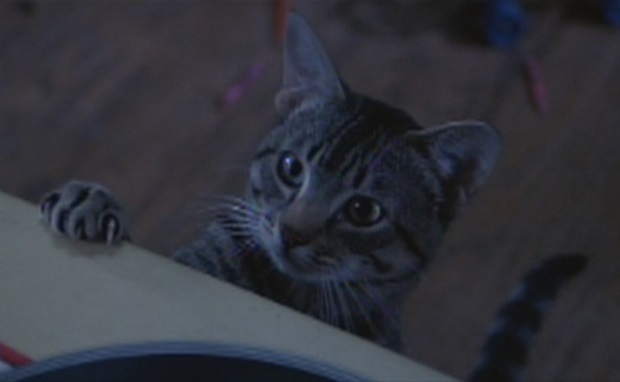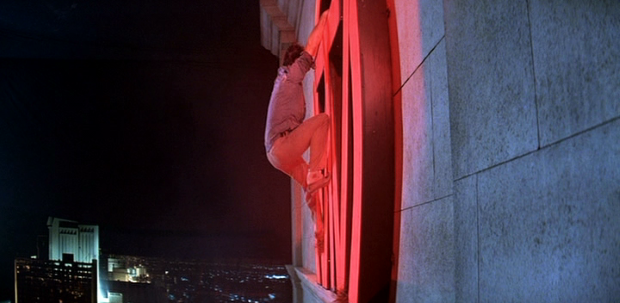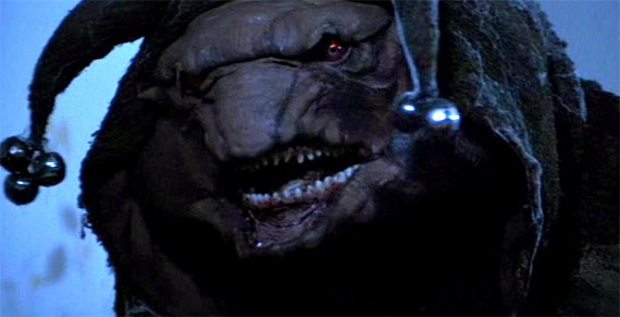Revisiting the film of Stephen King’s Cat’s Eye
Our lookback at the film adaptations of Stephen King's work lands on a gem: the anthology movie, Cat's Eye...
This article comes from Den of Geek UK.
The film: The second of our young Drew Barrymore in Stephen King films double bill, Cat’s Eye is another of his anthology movies. The spine of the film is a tabby cat, accidentally driven first to New York City where he receives a message from a girl (Drew Barrymore) who asks the cat for help. Before he can find her, the cat is captured by Quitters, Inc., a company that helps people to quit smoking with threats of torture and violence on the family, as Dick Morrison (James Woods) finds out.
From there, the cat travels to Atlantic City where he gets another message from the girl, but finds himself swept into a dangerous, vertigo-inducing bet between a husband (Kenneth McMillan) and his wife’s lover (Robert Hayes). He finally ends up at the suburban home of Amanda (also Drew Barrymore) who begs her parents to keep the cat, naming him General. Amanda’s been having bad dreams about an evil troll living in her wall and the cat arrives in time to save her.
As with previous anthology film Creepshow, King himself is on screenplay duties here, utilising two of his short stories (Quitters, Inc. and The Ledge) and adding a third (General), which is written especially for the film. Lewis Teague, last seen working on Cujo, returns for the directorial duties and works in a nod to his other King adaptation. It’s hard not to compare Cat’s Eye to Creepshow, given the format of the two films. The similarities don’t end there either; King’s sly, macabre sense of humour is allowed to flourish in the way he devises torturous experiences for his characters.

Cat’s Eye opts for a more realistic approach than the schlocky visuals and effects of the earlier film, which means that its imagery doesn’t stand out in quite the same way. However, it more than makes up for it with the three stories. The cat proves to be an effective way of getting from one story to the next, linking them neatly without ever feeling forced. The first story is that of Quitters, Inc., an example of King at his most dastardly. It’s a tale of the horrors of trying to break an addiction and the effect it has on the family, taken to its very extreme.
The company’s unusual methods to help someone stop smoking are to torture that person’s family should they start smoking again. The client is watched at all times and the second a lit cigarette touches their lips, their family is held accountable to teach them a lesson until eventually, the company ‘gives up’ and terminates the client. Woods gives a good performance, but it is the maniacal Alan King as the head of Quitters, Inc. who steals the show. Donatti is a great villain, whether it’s calmly electrocuting the poor cat, or miming along to a song in a party-based hallucination. He’s the most fun performance in the the movie (apart from the cat) and captures the mix between the blackly comic and the chilling elements.
The Ledge feels a touch repetitive as a result of its similarity to Something To Tide You Over from Creepshow (coincidentally starring another Airplane! star in Leslie Nielsen). Both feature a sadistic husband tormenting his wife’s lover in some fashion, but The Ledge is just as strong in the tension stakes. Here, Cressner, the husband, wages that Johnny, the lover, that he cannot walk around the narrow ledge at the top of Cressner’s building without falling to his death. If he wins, he gets his freedom, money, and Cressner will divorce his wife.

Teague spins a lot of dread from high angle shots of the traffic below the building, emphasising the distance that Johnny would fall should he lose his balance for one second. There’s even a particularly intense moment involving a determined pigeon that gets the heart racing. It’s a more visceral horror than the dread of Quitters, Inc., playing very deliberately with a common phobia and producing several hair-raising moments as a result. The score from Alan Silvestri is effective in this respect, a pulsating undercurrent that ramps up the tension for Johnny’s trip round the building.
General is the most outright horror-based tale of the three and plays directly with a fear that many of us had when we were children; something nasty lives in the bedroom wall or under the bed and it’s coming to get you. The troll itself is the result of some solid effects work, all glowing eyes and sharp teeth, with a goosebump-inducing laugh. There is also the element of frustration that kids experience when their parents don’t believe them. Barrymore’s Amanda is insistent that something is after and the cat can help, but her mother remains inflexible, sending General off to be euthanised by the animal shelter. General’s too cunning for that through.
Finally, it’s not often that an animal gets to be the standout star of the film, but the various cats who play General really do make the feline-based conceit work. Though he plays a more incidental role in the first two tales, General is a great showcase for the eponymous cat. The scene in the animal shelter is a prime example as the cat lies morose until he has the chance to plot his escape and run home to save Amanda. It feels a little bizarre to root so mightily for a cat versus a troll, but the final battle draws you in and both cat and troll convince in the scrap. The inventive use of perspective also gives it an epic feel too and neatly circumvents the potentially ludicrous nature of the scene.

Cat’s Eye may not have some of the bigger thrills that previous films in this rewatch have exhibited, but it’s a solid entry into the canon. It deftly manages the wry black comedy with the horror and fears it wishes to exploit and the quality across the three stories is largely great. Plus, it always helps to have a cute animal at the heart of your story, especially one who can battle trolls should the need arise.
Scariest moment: Johnny is doing well on the ledge as he moves around the building, but Cressner decides to start making him jump. The heart stops with every imbalance Johnny suffers through.
Musicality: One of the big running musical themes throughout the King movies we’ve looked at so far is the way in which the music is used as a wry commentary on the narrative. Another brilliant musical joke features here. Morrison is trapped at a party full of smokers, knowing he can’t partake without harm coming to his family and that he is watched at all time. The song that plays? Every Breath You Take. It’s also used later to great effect in General.
A King thing: Intra-King referencing. Part of the fun in reading King’s novels is to spot characters cropping up in other stories or references to previous plotlines. King and Teague gleefully carry over that love of connecting his work. It opens with the cat being chased by a rabid St Bernard as well as being nearly run over by a ‘58 Plymouth Fury… Morrison also sits watching the adaptation of The Dead Zone as he recovers from his first meeting at Quitters, Inc.
Join me next time, Constant Reader, for a Silver Bullet…
